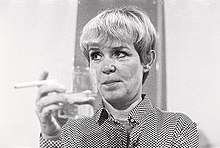Eugenia Butler
| Eugenia Butler | |
|---|---|
 | |
| Born |
Eugenia Louise Jefferson 1922 Bakersfield, California |
| Died |
December 21, 2001 (aged 79) Calabasas, California |
| Nationality | American |
| Occupation | Gallerist |
| Spouse(s) | James G. Butler |
| Children | 8, including Eugenia P. Butler |
Eugenia Butler (1922 – December 21, 2001) was an American art dealer and collector. In 1963, she became the American representative of Galleria Del Deposito, which featured work by European artists who made functional art objects, such as trays or jewels. She co-directed the Los Angeles Gallery 669 with founder Riko Mizuno from 1967,[1] and ran the Eugenia Butler Gallery on La Cienega from 1968 to 1971. Her gallery showed the work of conceptual artists, including John Baldessari, James Lee Byars, Douglas Huebler, and her daughter, Eugenia P. Butler.
Early life and family
Eugenia Butler was born Eugenia Louise Jefferson in Bakersfield, California in 1922.[2] She attended Scripps College and served as a master sergeant in the Marines during World War II.[2] After the war she married James G. Butler, a lawyer and former pilot who had accumulated a small fortune as a drug products lawyer.[3] They had eight children together.[4] Their daughter Eugenia became an artist.[5] In 1971, Butler was diagnosed with breast cancer. She received a mastectomy and later staged a wake at her home to partake in a performance funeral.[4] In 1972, Butler began an affair with the artist Paul Cotton. She left her family behind and moved to San Francisco with him.[4]
Career
Butler's first venture as an art dealer was to serve as the American representative of Galleria Del Deposito, which was established in 1963. Galleria Del Deposito was based in Genoa, Italy, and served as the exhibition space for Gruppo Cooperativo di Boccadasse, an artist collective Eugenio Carmi and Carlo Fedeli founded in Italy. The group made and sold functional art objects, and distributed monthly bulletins and a mail order catalogue to reach an international audience.[6] In 1967, she joined dealer Riko Mizuno as co-director of Gallery 669 on La Cienega Boulevard (Mizuno had opened the gallery the previous year, in 1966).[1] They exhibited paintings and etchings by artist Henry Miller and work by Ed Kienholz and gave Joseph Kosuth his first Los Angeles exhibition. After parting ways with Mizuno, Butler opened the Eugenia Butler Gallery in 1968, at 615 N. La Cienega Boulevard.[7]
Exhibitions
Butler's main focus for her gallery was on conceptual art consisting of mostly dematerialized and non-object oriented work. She was an early champion of conceptual art, developing the hallmarks of space, interaction and performance. During a period unfamiliar with non-object oriented art, Butler validated the development of conceptual art and made L.A. the center for its progress.[4] The gallery owner staged a 30-day exhibition for Icelandic artist Dieter Rot, which consisted of 20 suitcases filled with cheese.[2]
References
- 1 2 "PRELIMINARY INVENTORY OF THE MIZUNO GALLERY RECORDS, 1955-2005, bulk 1966-1988". Los Angeles, CA: The Getty Research Institute, Accession no. 2010.M.84. Retrieved 21 June 2014.
- 1 2 3 "Eugenia Butler; Art Collector and Dealer". Los Angeles Times. Retrieved 2014-03-09.
- ↑ "James Butler, 84; Groundbreaking Lawyer, Activist, Art Collector". Los Angeles Times. Retrieved 2014-03-09.
- 1 2 3 4 Stromberg, Matt (January 7, 2015). "Art of the Possible: A Reappraisal Of The Eugenia Butler Gallery". Artbound. KCET. Retrieved 6 November 2015.
- ↑ "DAILY SERVING » Eugenia is coming: LAND shows off Eugenia Butler in “Perpetual Conceptual”". dailyserving.com. Retrieved 2014-03-09.
- ↑ Los Angeles Nomadic Division. "LAND | DEPOSITO". nomadicdivision.org. Retrieved 2014-03-09.
- ↑ "Eugenia Butler Gallery » Pacific Standard Time at the Getty". blogs.getty.edu. Retrieved 2014-03-09.